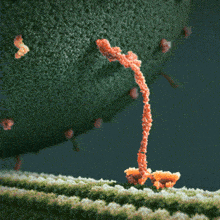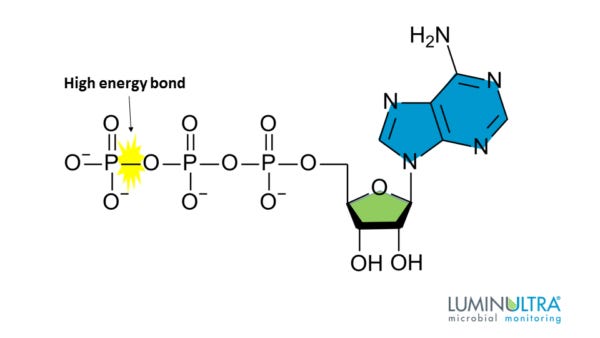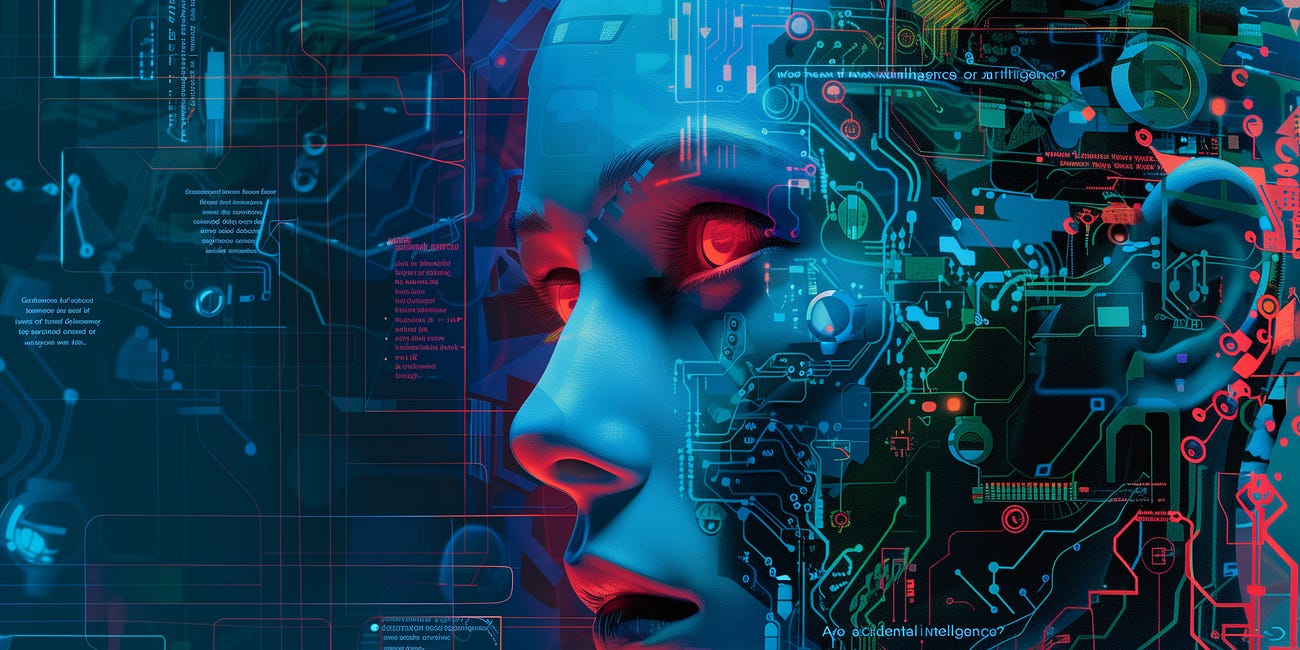Our Cellular Machinery
In this rabbit hole, we learn how DNA produces micro machines, which construct cells that have all the same components as modern computers.
Proteins are way more than just the choice of meat that goes on your salad. Proteins are molecular machines. Some have tiny little legs that walk, like this kinesin motor protein that delivers supplies within our cells.
Others have motors that spin, like this flagellum motor protein that cells use to swim around. This motor has 50 parts, uses mechanical leverage, and spins faster than a diesel engine.
Whenever we eat “protein”, we ingest all the little micro machines inside those plants and animals. Our digestive system crushes, chews, ferments, sieves, and strains our food to extract all the little micro machines inside. We chemically strip them down for parts to make our better, stronger micro machines from our better, stronger DNA. That’s why the law of the jungle is eat, or be eaten. As each animal lives their life, they slowly reorganize the world into these little micro machines.
The average person is 60% water, 20% fat, 15% protein, and 5% minerals (like salts and metals). So almost every part of your body that isn’t fat or water, is made out of these micro machines. They construct and operate our cells. They lock together to make bones and muscles. They are used as hormones in our blood and enzymes in our guts. Some are even used as neurotransmitters in our brains.
To see more of our “nanobots” in action, check out this video from Veritasium called, Your Body’s Molecular Machines. (6 mins)
How Our Software Makes Hardware
In Human Source Code, we learned how various segments of our DNA are used for various purposes. Some sections are used for environmental regulation and logical decision making. Other sections are used for error handling and anti-virus protection. Only about 3% of our DNA is used to make proteins. By contrast, 98% of the DNA inside bacteria is used to make proteins.
The segments of DNA that make proteins are called Protein Coding Genes and they all make their proteins the exact same way. According to Francis Crick, who discovered the double helix with James Watson, genetic information flows in one direction: from DNA to RNA to Protein. This is called The Central Dogma of Molecular Biology.
When a gene is ready to build a protein, it doesn’t just send its source code to the “micro machine factory”. The DNA splits in half, and the gene splices together multiple segments of its source code to produce Messenger RNA, or mRNA. Messenger RNA is the actual blueprint for a protein. We aren’t really sure how genes decide which DNA letters to keep and which ones to ignore. The resulting mRNA is what gets sent to the “micro machine factory”, which is called a Ribosome.
Whenever a ribosome encounters new RNA, it automatically begins a new string of Amino Acids. Amino acids are not the same as DNA and RNA, which represent information. Amino acids are the actual building blocks of life. Here’s what that process looks like in an electron microscope.
Surprisingly, there are only 20 amino acids. Here’s what they look like in chemical notation (chemistry).
The smallest amino acid, Glycine, only uses 10 atoms from the universe while the largest amino acid, Tryptophan, uses 27 atoms. They may look simple, but these 20 amino acids produce all 200 million proteins we find in nature, just by changing the order they are strung together.
The way ribosomes string them together is very “computer sciency”. Ribosomes read 3 RNA letters at a time, which is called a Codon. A codon is like a byte in computer science:
A byte holds 8 bits of uncertainty that are either 0 or 1, which produces 256 possible states of information (2^8).
A codon hold 4 different values (G,A,T,C) in 3 positions, which produces 64 possible states information (4^3).
Here is a Codon lookup table that illustrates how each three-letter codon maps to each amino acid. Geneticists replace the DNA letter ‘T’ with the letter ‘U’ to indicate these sequences are RNA.
This translation is exactly the same in every form of life. Matt Ridley illustrates this point well in his book, Genome: The Autobiography of a Species in 23 Chapters.
Ridley writes,
The three-letter words of the genetic code are the same in every creature. CGA means arginine and GCG means alanine – in bats, in beetles, in beech trees, in bacteria. They even mean the same in the misleadingly named archaebacteria living at boiling temperatures in sulphurous springs thousands of feet beneath the surface of the Atlantic ocean or in those microscopic capsules of deviousness called viruses. Wherever you go in the world, whatever animal, plant, bug or blob you look at, if it is alive, it will use the same dictionary and know the same code. All life is one.
If you examine the codon lookup table closely, you’ll notice it also has a “Stop command”. UAA, UAG, and UGA all mean stop, which tells the ribosome to cut the string of amino acids loose so it can fold up into a little micro machine like a transformer.
How strings of amino acids transform into sophisticated micro machines with legs, motors, valves, and pumps was a big mystery in biochemistry for over 50 years. My favorite explanation for how this works is a TED Talk from Ken Dill called, The protein folding problem: a major conundrum of science. I’ve watched 3 times. (16 mins)
The reason amino acids can transform into micro machines is because they are self similar. They all have an amino group of molecules on one end (NH2) and a carboxyl group on the other end (COOH) that are polarized. So amino acids chain together like a toy train. What makes each amino acid unique is its side chain. Some side chains are polar, which enables more than two polarized connections. Other side chains are non-polar and vary in shape. Side chains give each protein their unique three-dimensional structure.
The average protein uses between 200 and 400 amino acids to create its shape, but that number can vary widely. Insulin only needs 51 amino acids in a very specific order while our largest protein, Titin, needs 34,350 amino acids in a very specific order. Titin is the scaffolding for our muscle fibers. To see more of our proteins in action, don’t miss this amazing video from Harvard BioVisions called, Protein Packing Inside the Cell. (4 mins) 🤯
@programmers: Our DNA software uses a build process that is incredibly similar to the way we build computer software:
DNA is basically the “human.c” file that holds our source code.
MessengerRNA is basically the “human.o” object file that gets assembled by the C compiler.
Proteins are the “human.exe” output that does real stuff in the real world.
The build process, the lookup table, and all the various micro machines are just a few reasons why I believe humans are artificial intelligence, as opposed to accidental intelligence (Darwinian Evolution).
Cellular Cluster Computing
The human genome (all 3 billion letters of our DNA) is only 715 megabytes of information. And somehow our DNA only needs 3% of that information to create more than 100,000 unique proteins in the human body.
Most proteins are used to manage and operate Cells, so let’s take a quick tour through a human cell to see more of our “nanobots” in action. (4 mins)
Cells are many orders of magnitude larger than proteins and many orders of magnitude smarter than proteins. Inside each cell are all the functions we expect to see in modern computers:
Cell Nucleus - This is obviously the Microprocessor. We learned how the nucleus works in the previous two essays. For a quick reminder, take this tour of a cell nucleus. Notice the size of the gateways in the firewall—our cells are really high tech. (7 mins)
Endoplasmic Reticulum - This is the System Bus of our cellular computers. A bus, or omnibus, is essentially the data highway in a computer that feeds information to the microprocessor. Any component that needs to send or receive data is plugged into the system bus.
If you recall from the videos above, the endoplasmic reticulum runs right through the nucleus. For whatever reason, the nucleus perpetually creates new endoplasmic reticulum while destroying the old, so each nucleus perpetually paves its own information highway.
Ribosome - These are similar to Printers. They turn information into real things in the real world. Some mammalian cells have 10,000,000 ribosomes ready to go at all times. Ribosomes hang out on the endoplasmic reticulum which gives it the “rough” appearance under a microscope. Ribosomes join 200 amino acids per minute, so most proteins are created fairly quickly. But massive proteins, like titin, need 2-3 hours to construct.
Golgi Apparatus - This works like a Modem. Ribosomes somehow know when a protein is destined for a location outside the cell. So ribosomes can untether themselves from the endoplasmic reticulum and travel to a Gogli apparatus along the outer walls of the cell to finish the job offsite. The Golgi apparatus then exports the new protein outside the cell without getting any yucky cytoplasm on it.
Lysosome - This is the Recycle Bin of our cellular computers. After proteins serve their purpose, they are sent to the lysosome, which breaks them down into amino acids to be used in new proteins.
Wiki: A lysosome is a membrane-bound organelle found in many animal cells. They are spherical vesicles that contain hydrolytic enzymes that can break down many kinds of biomolecules. A lysosome has a specific composition, of both its membrane proteins, and its lumenal proteins. The lumen's pH (~4.5–5.0) is optimal for the enzymes involved in hydrolysis.
Vesicle - This is a Partition. Computer programmers use partitions when they want to try out new software, but don’t want to risk contaminating their existing code.
Wiki: Vesicles are a basic tool used by the cell for organizing cellular substances. Vesicles are involved in metabolism, transport, buoyancy control, and temporary storage of food and enzymes. They can also act as chemical reaction chambers.
Centrosome - This is the BIOS or UEFI of our cellular computers. UEFI stands for Unified Extensible Firmware Interface. The UEFI in a computer is responsible for powering on each component, connecting them to the system bus, and loading the operating system into memory. The UEFI is limited in its decision making compared to the microprocessor, but nothing happens in a computer without permission from the UEFI.
Wiki: The centrosome is an organelle that serves as the main microtubule organizing center (MTOC) of the animal cell, as well as a regulator of cell-cycle progression. The centrosome provides structure for the cell.
The centrosome instructs each cell:
how to orient itself in space
where to go
when to replicate, and
when to die from programmed cell death
The centrosome also does some amazing things with microtubules that microbiologists are only beginning to understand. If you recall the OrchOR Theory by Sir Roger Penrose and Stuart Hameroff, our brains perform quantum computation at room temperature using microtubules. They act like little vacuum tubes that resonate with the vibes of the quantum universe. So the centrosome may provide some kind of connection to reality that we don’t understand yet. You can learn more about microtubules in:
@quantumbiologists: if you want to dive even deeper into microtubules, check out this presentation called, Clarifying the Tubulin bit/qubit. Stuart Hameroff makes a strong case that microtubules also store our memories. (46 mins)
Mitochondria - are the Power Supply Units (PSU) of our cellular computers. Every cell has multiple power supply units. Liver cells, for example, have around 2,000 mitochondria each.
Star Wars fans may naturally confuse mitochondria with “midi-chlorians”, which are the mysterious life form that live inside the cells of the Jedi, giving them power from the Force. Well, mitochondria are very similar. They supply power to all our proteins in the form of a molecule called Adenosine Triphosphate.
Wiki: Adenosine Triphosphate (ATP) is an organic compound that provides energy to drive and support many processes in living cells, such as muscle contraction, nerve impulse propagation, condensate dissolution, and chemical synthesis. Found in all known forms of life, ATP is often referred to as the "molecular unit of currency" of intracellular energy transfer. The human body recycles its own body weight equivalent in ATP each day. It is also a precursor to DNA and RNA, and is used as a coenzyme.
Plug and Play by Design
Mitochondria are unique because they are the only cellular component that has its own DNA. They produce ATP to power our proteins through Aerobic Respiration, which means they breathe oxygen. When our muscles work hard and our lungs huff and puff, none of that oxygen is actually going to “us”. We feed all that oxygen to our mitochondria because their metabolism yields:
30 molecules of ATP per 1 molecule of glucose when oxygen is present, or
2 molecules of ATP per 1 molecule of glucose when oxygen is not present
So the oxygen we breathe makes our mitochondria 1500% more efficient. Here’s a video from Harvard BioVisions that shows how the pumps and valves inside a mitochondrion work. (4 mins)
The waste products from mitochondria are carbon dioxide and water. So every time we exhale, we are releasing the waste products from trillions of mitochondria “batteries”.
Mitochondrial DNA is more closely related to bacterial DNA than it is to human DNA. So mitochondria really are the mysterious life form that lives inside our cells to give us power. This has led to the Symbiogenesis Hypothesis, which states,
Free-living prokaryotic ancestors of modern mitochondria permanently fused with eukaryotic cells in the distant past, evolving such that modern animals, plants, fungi, and other eukaryotes are able to respire to generate cellular energy.
This theory is widely accepted among microbiologists, but it doesn’t even make “evolutionary sense” to me. Remember how we have 100,000 unique proteins in our body? NONE of those genes evolved to use oxygen, ever, despite the fact that they supposedly evolved in the presence of oxygen over millions of years. Think about how improbable that is. That’s not really “symbiogenesis”, that’s more like, “In the beginning there were mitochondria producing ATP, and then there was everything else”.
Symbiogenesis is the only reasonable explanation for our microbiology if you are committed to the belief that humans are accidental intelligence from millions of years of evolution and natural selection. But if humans are artificial intelligence, then we were designed to incorporate mitochondrial DNA on purpose. That makes mitochondria a very critical design choice.
I don’t presume to know why our Creator gave us mitochondria batteries, but I do know why a software designer on Earth would do it—to make all 3 billion letters of the human genome “Plug and Play”. By simply swapping out the DNA inside our mitochondria, the rest of our DNA could easily work on multiple planets with multiple atmospheres without any other modifications.
Our bodies run on ATP. If we swapped out our mitochondrial DNA, we could use nitrogen, carbon dioxide, or even argon to turn 1 glucose molecule into 30 ATP molecules. We might need small changes to our lungs and Red Blood Cells, but that may have already happened to us. For example, mature red blood cells are the only cells in the human body that don’t have a nucleus. They don’t even have mitochondria. Red blood cells have RNA, which means they are kind of like a virus that we give to ourselves. Why is that? 🤔
Red blood cells are red for the same reason rust is red—iron is the central atom in our hemoglobin protein. Our bodies make 2,000,000 red blood cells every second and discard so many that they turn our poop brown. When we eventually meet aliens from other planets, the color of their blood, the color of their skin, and the color of their poop will most certainly be determined by the molecules they breathe. 🩸
@biblenerds: This plug and play mitochondria idea makes Genesis 1:26 even more intriguing. In English it reads,
Then God said, “Let Us make man in Our image, according to Our likeness. They will rule the fish of the sea, the birds of the sky, the livestock, all the earth, and the creatures that crawl on the earth.”
But in Hebrew, the word translated as man is adam. Adam isn’t a name, it’s a color. It means red or ruddy. So technically, the first man spawned on this planet got to name all the other creatures on Earth except himself. He received the name “red” from beings known as the elohim, which is translated as “God” in English.
Elohim is the plural of eloah, which means “Ruler from above”. We obviously look exactly like these “Rulers from above” because we were made in their image. So maybe somewhere else in the universe are beings who just look like us, but they have yellow blood, blue blood, or green blood. Why else would we be distinguished by the color red?
Genesis 1:26 literally reads,
Then elohim said, “Let us make red in our design, according to our form”.
Genesis 5:2 confirms our color,
He created them male and female. He blessed them and called them red on the day they were created.
To learn more about the elohim, read:
Continue reading…
Fiber Optic Carbon Fibers
Did you know our bodies are constructed from the most high-tech fabric in existence? Our fascia conducts light, heat, sound, force, and even generates its own electricity. ⚡️
Table of Contents
The Computer Science of Everything
God isn’t some old, white man with magical powers. God is a quantum computer scientist with super advanced technologies.
Huge Thanks 🙏
to all our sponsors. Your support helped us reach new academics, scholars, and scientists all around the world through social media.
Caitlin Knauss
Worth Denison
Alana Aviel
Anonymous
Jeremy Wells
Ronnie Blanton
Tarrytown Bible study
If this content was helpful to you, please consider investing in our mission to spread the Good News of Jesus Christ. “Love your neighbor as yourself” might be the only reason that artificial super intelligence doesn’t kill us all.
Donate by credit card or bank transfer:
Donate Bitcoin to this address: bc1qsn9xrd3yrfg4zqydc5aqns3uwvhrdqay8d7vht
Donate by subscribing to our investor newsfeed:
Wanna chat about this story? Email us or leave a comment below:
What did you love the most?
What did you hate the most?
What surprised you the most?
What confused you the most?

































